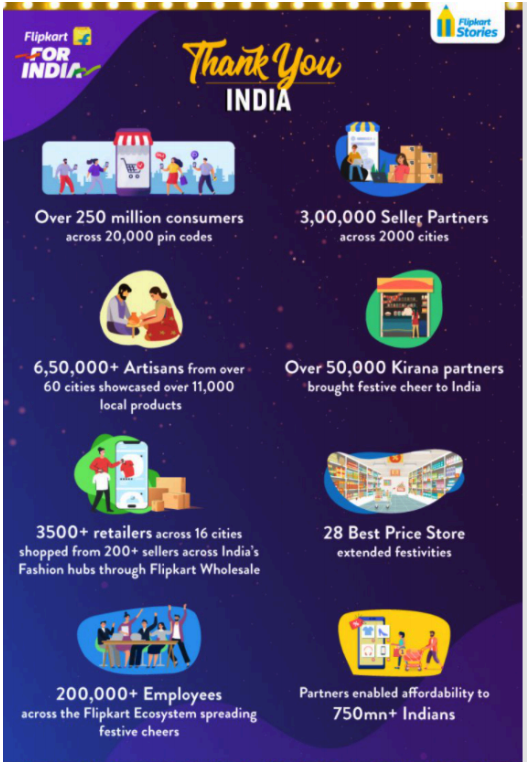
Nitheesh NH
What’s the Story?
Flipkart’s annual flagship shopping event, Big Billion Days (BBD) 2020 came to an end on October 21. This year’s festival ran for six days and saw considerable interest, excitement and engagement during the event. Flipkart has not released total sales numbers, and many of the metrics it has published are indirect (such as number of sellers) or in absolute terms rather than in growth terms (such as number of deliveries completed within five days).Why It Matters
This year’s BBD was much anticipated both for consumers and sellers, as well as for industry observers: It is the annual flagship event of India’s biggest e-commerce marketplace and took place in a depressed consumer market this year—albeit relatively favorable for e-commerce in comparison to in-store retail—amid the Covid-19 crisis.Big Billion Days Wrap-Up: Focus on “Tier 2 and Beyond” Regions Drives Growth
BBD 2020, the annual shopping festival’s seventh edition, had a solid impact on micro, small and medium enterprises (MSMEs), particularly in Tier 2 and Tier 3 towns, according to Flipkart. The platform focused efforts toward penetrating deeper into non-Tier 1 cities and towns, which proved pivotal to its success. Flipkart did this by improving last-mile delivery capabilities, offering affordable financing options and introducing regional language interfaces, among other key initiatives. Of the 35%+ new sellers during this BBD, about 60% came from Tier 2 and Tier 3 towns. The “Flipkart Samarth” program for artisans and weavers recorded a sevenfold increase in the number of sellers. With the program having reached “7X” more cities, more than 60%+ Samarth sellers were from “Tier 2 and beyond” cities, with categories such as handloom cotton saree and home decor being among the top performers. Nandita Sinha, Vice President of Customer Growth and Engagement at Flipkart Group, said:Flipkart’s aim this festive season has been to bring resilience back into the community. The remarkable enthusiasm from consumers has ushered in green shoots of recovery for everyone across the value chain. TBBD 2020 has been a celebration of sellers, artisans, kiranas and Wishmasters, who have delivered unmatched value to our consumers.
The revival in demand and resurgence of consumption is expected to remain even after TBBD, as we continue to uplift the entire ecosystem. This was also the first completely virtual BBD, as we adapted to the advent of a “new normal,” and its success comes on the back of the hard work of our teams across verticals and locations.
Key Highlights from BBD 2020 Flipkart’s reported metrics give little indication of the extent to which sales grew year over year, whether in total or by category. The press release did not unequivocally indicate that total sales grew versus 2019, while a number of data points focused on indirect metrics such as the absolute volume of deliveries in the first few days, the number of new sellers or figures for page visits. The following are some of the metrics from BBD 2020 as announced by Flipkart:- More than 666 million page visits were recorded over the duration of the event, with over 52% of these coming from “Tier 3 cities and beyond.”
- The platform recorded 100 order placements per second.
- More than 10 million deliveries were completed in the first five days of BBD, with over 3.5 million via partner kiranas (local convenience stores).
- The platform saw “1.5X” the number of transacting sellers versus last year, of which over 35% witnessed “3X” more sales compared to BBD 2019. Flipkart catered to over 250 million consumers in India, across 20,000 postal codes.
- The number of “Crorepati sellers,” meaning those that generated sales in excess of ₹10 million (around $136,300), grew “1.5X”. The number of “Lakhpati sellers”, meaning those that accumulated earnings of over ₹100,000 (around $1,360), registered a “1.7X” jump.
 Source: Flipkart[/caption]
Source: Flipkart[/caption]